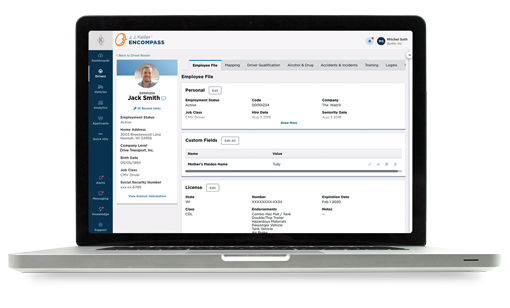Sr. Industry Business Advisor — J. J. Keller & Associates, Inc.
Driver Roadside Inspection Checklist
Drivers are on the frontline of a roadside inspection. Here's how to help them prepare.
Published On: 03/19/2020


Written by:
Tom Bray
The driver is on the frontline of a roadside inspection and his or her level of preparedness directly impacts the success of the inspection. Additionally, how they respond to the enforcement officer is equally as important. Being courteous, following instructions, making eye contact, and answering questions truthfully go a long way to expediting the inspection process and getting back on the road. Have drivers review the checklist below for tips on how to have a successful inspection. Download this checklist here.
Avoid Unnecessary Inspections
While drivers cannot control if they are selected by ISS for an inspection, they can ensure that there are no egregious and visible violations that would give cause for an enforcement officer to conduct a roadside inspection.
- Conduct thorough pre-trip inspections and address any identified defects before operating the vehicle.
- Conduct thorough post-trip inspections and use the DVIR process to make sure the company is aware of and addresses any defects.
- Make sure the company name and DOT number remain visible and readable.
- Drive defensively and in compliance with the traffic regulations.
The Inspection Process
Have drivers review the checklist below for tips on how to have a successful inspection.
THE EARLY INSPECTION PHASE
Drivers can avoid problems early on in the inspection process if they:
- Follow the officer’s instructions.
- Move to the inspection location requested.
- Remain reasonably still in the cab until the officer provides further instructions.
THE INTERVIEW PHASE
Drivers can avoid problems during the interview process if they:
- Never operate when ill or fatigued, or after using any drugs or alcohol.
- Be professional, polite, and courteous during the greeting and interview.
- Answer the officer’s questions truthfully. During the course of the inspection, the officer will catch on to any inconsistencies or untruths told during the interview.
DRIVER DOCUMENT CHECK
Drivers should address the officer's request for documents accordingly:
- Always have his or her license and medical card (if a non-CDL driver) in his or her possession.
- Know the location of the company and vehicle credentials.
DRIVER CREDENTIAL CHECK
When the officer checks the driver's credentials, drivers need to:
- Make sure they keep their license and medical card valid at all times (renew their licenses and medical cards before they expire, submit their medical information to the state when required, etc.).
- Notify the company if a credential has expired or is lost, revoked, suspended, etc.
HOURS OF SERVICE CHECK
To prevent issues from arising during the hours-of-service portion of the inspection, drivers should:
- Never disconnect an ELD or tamper with the device or the data it collects.
- Log in and out of the ELD at the appropriate time, enter information when required, make duty changes when required, and log on-duty activities as on-duty time.
- Use the device as recommended by the manufacturer and company.
- Verify that the following are in the vehicle during pre-trips (these can be electronic):
- The ELD user’s manual.
- The ELD data transfer instruction sheet.
- Instructions to be followed in case of a malfunction.
- Eight blank paper logs.
- Be prepared in case of an ELD malfunction:
- Immediately notify the company.
- Immediately reconstruct the current and previous seven days.
- Retain a copy of the notification provided to the company.
- Secure a copy of the extension letter if the device has been malfunctioning for more than eight days.
- Use the special driving category only when the situation clearly matches the requirements for use.
- Make edits only to correct errors and omissions, and include a comment clearly explaining the reason for the edit.
- Set the device to the roadside inspection mode and display logs to the officer when requested.
- Transfer the log data to the officer using the agreed upon transfer method when requested.
- Place a comment (annotation) on the log anytime a limit is exceeded, explaining the situation, and if applicable, what exemption was used.
- If using paper logs, keep the log current and accurate.
- If using time records, explain to the officer that.
- Answer any questions the officer may have truthfully.
DVIR CHECK
When DVIRs are requested and examined by enforcement, drivers should:
- Conduct the daily driver inspections and address any defects as soon as they are discovered.
- Record a vehicle defect at the end of the day and immediately submit the DVIR.
- Look for any outstanding DVIRs when conducting a pre-trip. The location of DVIRs are determined by the carrier and should be known by all drivers.
Avoid Annual Inspection Violations
Violations can be avoided when the annual inspection is verified if drivers:
- Know the location of the proof of annual inspection.
- Check the annual inspection date as part of all full vehicle inspections.
Avoid Vehicle Violations
To avoid violations being discovered during the vehicle portion of the inspection, drivers should:
- Conduct a thorough pre-trip inspection before operating the vehicle.
- Conduct walkaround inspections any time the vehicle is parked.
- Report any defect discovered during an inspection to the company immediately.
Get Our Step-by-Step Guide to Roadside Inspections
Our subject matter experts walk you through a roadside inspection from selection to completion. They detail each inspection step, what the officer will ask for and look at, and how your driver and unit can be prepared. Free download.
You may also enjoy the following articles:
Sign up for our newsletter!
We'll help you stay on top of regulations, best practices, and fleet industry news. Sign up to receive a monthly email notification with links to our most recent blog articles, free resources, and event invites.
